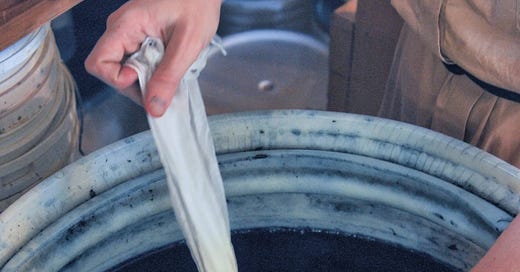💡 Investment Notes: Why we invested in Stony Creek Colors
Making fashion more sustainable with plant-based indigo
What does it take to dye a pair of denim jeans blue?
From the time it first became commercial feasible to produce synthetic indigo dyes, their use has become so ubiquitous that few stop to think about what it really takes to make the 142 million pounds of synthetic indigo dyes used by denim mills every year.
But the number of chemicals involved in dying clothing blue can be dizzying. Just manufacturing indigo involves the highly hazardous benzene-derivative called aniline as well as cyanide and formaldahyde. Subsequently getting that indigo to “stick” to fabrics like denim requires a group of “dye fixing” compounds known as mordants. These chemicals are all energy-intensive to produce, require the use of strong acids in high concentrations, and creates unstable and explosive byproducts such as dinitrophenol, picric acid, dinitrobenzene and nitrobenzene.
And then there are also the downstream effects to consider as well, such as the water contamination from the extremely toxic textile dyeing effluent. It has made the East River in Xintang, China so polluted that “you can’t give away houses for people to live there.”
Stony Creek Colors is looking to shift the fashion industry away from these harmful, petroleum-derived synthetic dyes. Here’s why we’re investors in Stony Creek Color’s US$9M Series B round.
1) Innovations across the supply-chain
Stony Creek Colors has innovated along the entire plant-based indigo supply chain end-to-end, to enable the shift away from synthetic dyes at scale.
Through traditional crop breeding methods at their own research farms, Stony Creek Colors has improved their indigo crop’s genetics, creating breeds of indigo that are climate-resilient, high-yielding, and suitable for different climates across the United States.
They’ve also developed proprietary technology to improve the efficiency and quality of harvesting, dye extraction, and processing. They’ve overcome the technical challenges of fresh indigo’s quick chemical degradation and solubility issues, and have increased the extraction yields of the indigo by 80% compared to the fresh leaf method.
As their indigo is chemically identical to synthetic indigo, it can fit in seamlessly with the existing manufacturing outfits of large clothing brands, removing a major barrier to adoption. Stony Creek Colors has thus successfully connected the final indigo product to market, securing large offtake agreements with large brands such as Patagonia, J.Crew, and Lucky Brand.
2) Mission alignment
In addition to being commercially viable, Stony Creek Colors is creating positive change both in terms of environmental and social outcomes.
Environmentally, for every ton of indigo that the company produces, they estimate that approximately 121 tons of CO2 equivalent are sequestered in soils and in vegetative biomass.
Stony Creek Colors’ indigo is also leguminous, helping to “fix” nitrogen in soil, via mutually-beneficial relationships with soil-dwelling bacteria known as rhizobia. This allows farmers to decrease their dependencies on synthetic fertilizers to fulfil the high nitrogen demands of other cash crops such as tobacco, grown in rotation with the indigo.
Nitrogen Fixation: The process in which free, relatively inert nitrogen which is found abundantly in the air as N2 is converted into a more reactive, bio-available form for plants to take up and use. Plants use nitrogen to create cellular constituents like chlorophyll amino acids, and nucleotides.
Socially, they’re raising farmer incomes by paying higher prices for the indigo than they can get from other commodities, while also reducing input and labour needs. For example, not only is indigo less susceptible to pests than other crops, it also lowers the nematodes numbers which affect cotton, soybeans and yams crops, allowing farmers to spend less time doing pest control.
3) The market opportunity
The total addressable market for premium dyes for textiles offers a US$4.2 Billion market opportunity.
Stony Creek Colors aims to capture 6% of this market by 2030, amounting to US$256 Million.
Add in plans to also to enter the food colorant market, which has a total market size of $2.2 Billion, and the potential for the company expands even further.
Indigo carmine, the most utilized synthetic derived indigo blue color alone has a market of US$142 Million in the U.S. and approximately US$300 Million globally.
All in all, we’ve been impressed with the Stony Creek Colors’ team’s transformation of the plant-based indigo supply chain, which represents ten year’s of work in R&D. We’re excited to be supporting their work and to see the company demonstrate the financial viability of regenerative practices.
You can find more about Stony Creek Colors at their website, Linkedin, Twitter, Instagram and Facebook.
Enjoyed these notes? Check out the the quick version of our investment spotlights on Linkedin (and share it with your friends!), and be sure to subscribe for more updates.




